

West Africa (2006)
From Casablanca to Cape Town
We have traveled to Africa on five earlier occasions but have never had an opportunity to visit West Africa. When we learned about a rarely scheduled cruise to the region, we were quick to sign up, intrigued by stories of voodoo, slave trading and mystery. This twenty-two day journey gave us a chance to sample a dozen different countries as we voyaged seven thousand miles along the West Coast of Africa from Casablanca to Cape Town.
|
|
 |
ms Prinsendam - Dakar, Senegal Cruise Itinerary - Lisbon to Cape Town
M/S Prinsendam. Our cruise ship was built in 1988, refitted in 2005 and is operated by the Holland-America lines. Displacing 38,000 tons and carrying 750 passengers and a crew of 425, the Prinsendam is one of the smaller cruise ships on the open seas, only a quarter of the size of some of the more recently built, super sized cruise ships. It was small enough to provide a feeling of intimacy but large enough to navigate the gray waters of the Atlantic in comfort. At 38,000 tons, in fact, it is the same size as the USS Kearsarge (CVA-33), the World War II aircraft carrier that was my sea-going home for three years in the late fifties.
The Prinsendam, however, included a few amenities that we didn’t enjoy on the Kearsarge: large staterooms with queen-sized beds, walk-in closets, private bathrooms, terry cloth bathrobes and large picture windows; four elegant restaurants, seven bars, a 300 seat theater with live shows every night, two swimming pools, a fitness center with a full spa and a Las Vegas style gambling casino. About the only thing the ship didn’t have was a flight deck for launching and recovering airplanes.
For many of the ship's passengers, the cruising life on board was an end unto itself; for us, the ship was basically a way to take us to a part of the world which would otherwise be pretty much inaccessible by air or by overland travel. At each port of call, we usually took full day tours away from the cities and out into the rural areas. Since most of the ports on our itinerary were rarely visited by tourists and even more seldom by cruise ships, the tours were not always comfortable or well organized but each day offered a new adventure.
History. West Africa is geographically defined as that western portion of the continent which protrudes out into the Atlantic Ocean and which extends from the Sahara desert down to the Gulf of Guinea, where the coastline turns south again. The region includes a total of eighteen countries.
Although the history of West Africa can be traced back several millennia, it was first discovered by the Europeans in the 15th century when Vasco da Gamma and other Portuguese navigators sailed down the coast in search of a sea route to India. The rich natural resources of West Africa gave rise to an increasing trade with the Europeans. The colonial names given to various coastal regions indicate some of their principal items of commerce: the Ivory Coast, the Gold Coast, the Grain Coast and the infamous Slave Coast.
In the late 19th century, the European imperial powers, principally England and France, staged a major “Scramble for Africa” and occupied most of the west coast, creating colonial nation states. This colonial occupation continued until the conclusion of World War II, when all the colonies gradually obtained their formal independence. The European insistence on drawing arbitrary borders around their colonial territories often separated ethnic groups, which shared a common language, culture and traditions, with devastating sociological consequences.
Since colonialism, many West African states have been plagued by instability, corruption and violence. Poorly prepared for their independence, few nations in West Africa have been able to sustain democratic governments and many have cycled through a series of brutal coups and military dictatorships. As a result, Africa has remained the world’s poorest inhabited continent and the gap with the rest of the world continues to grow.
Morocco. (Casablanca) Our first African port was Casablanca, a modern seaport with a strong French accent. With only one day in port, we had to choose between touring Casablanca in the hopes of spotting Humphrey Bogart and Ingrid Bergman at a back table in Rick’s Café or heading off on a four hour bus trip to the fabled city of Marrakech. Winston Churchill once advised, “If you only have one day to spend in Morocco, spend it in Marrakech.” Having learned recently that Sir Winston was one of my distant cousins, we felt compeled to take his advice.
Built in the 11th century as the capital of the nomadic Berber people, Marrakech is an exotic melting pot of the Berber, Arabic and African cultures. The tour included visits to the 12th century mosque, the King’s palace (Kasbah) and the huge central market square which is like an around-the-clock street circus. If the snake charmers, performing monkeys, acrobats and dancers are there for the tourists, the dentists, barbers and scribes are there for the locals. It is one oversized food court with everything from kebabs and couscous to sheep brains cooked in their own skulls.
Marrakech is considered one of the gateways to the Sahara Desert. Looking south from the ramparts of the walled city, one can see the majestic Atlas mountains in the distance. Beyond the mountains lies the great Sahara Desert, a vast expanse of sand, 3,000 miles wide and 1,500 miles across, larger in size than the United States. It was here that great camel caravans of upwards of a thousand camels once left for the ancient, desert city of Timbuktu and on to sub-Saharan Africa carrying textiles, silks, beads and utensils to trade for gold, ivory, ebony and slaves. These were the true adventure travelers.
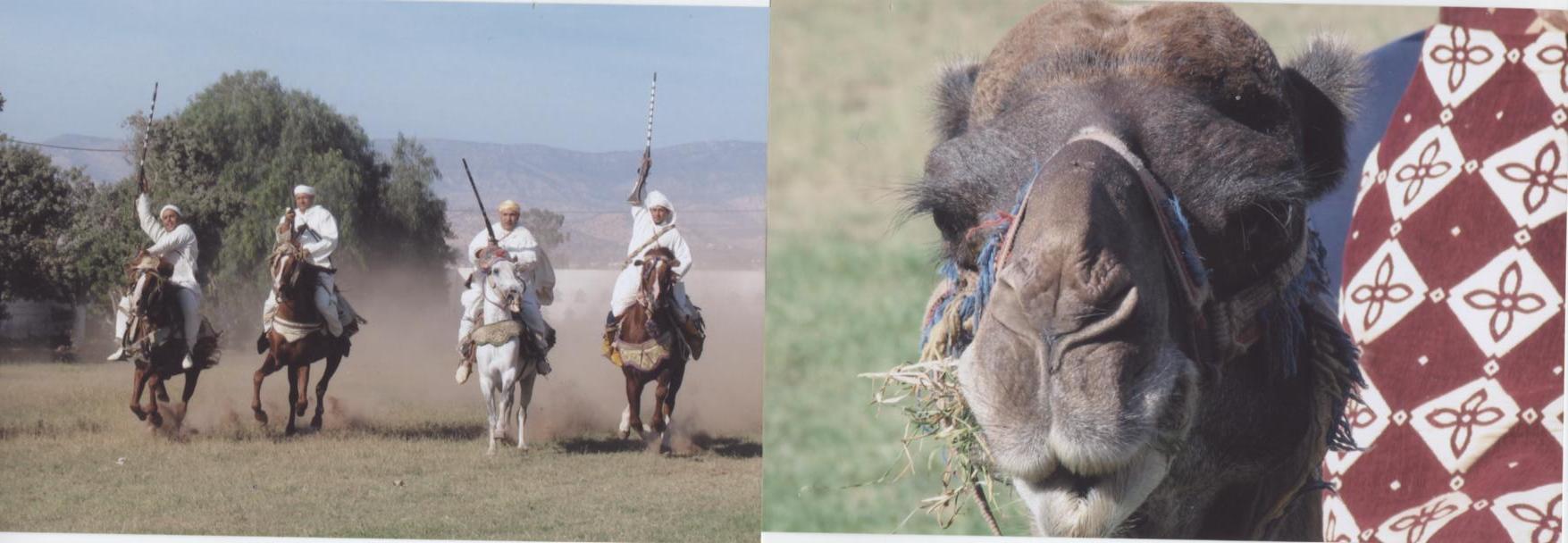
Berber Horsemen - Morocco A Ship of the Desert
Our second port-of-call in Morocco was Agadir, a modern resort town on the west coast. Almost totally destroyed by an earthquake in 1960, the city has been rebuilt with modern houses, attractive hotels and wide boulevards. We spent our afternoon riding on camels and watching Berber horse racing, It was touristy but fun nevertheless.
Senegal. (Dakar) The port city of Dakar is Africa’s westernmost city and a major sea and air port, lying halfway between Europe and South Africa. Rather than spend our day in the city, we opted to take the fifteen minute ferry boat ride to the Isle of Goree, which was once an important center of the West African slave trade. At first sight, the island seems to be a place of idyllic beauty and tranquility with its charming pastel houses set against the blue of the sea and the green of its gardens. Yet, just beneath the surface, lies its murky history, where many of these same houses once held slaves for weeks and months in dark, dank basements to await transport across the ocean into a life of slavery.
Although we have heard the grim stories of slavery all of our lives, to actually be confronted with the stark realities of this terrible period in history leaves an impact in way that no history book can. Walking around the site, entering the dungeons and listening to the stories told by our Africa guides was an unforgettable experience. We noticed several Afro-Americans on our tour and thought that, to them, a visit to the slave forts must have been like a visit to Auschwitz for Jews. It must have been hard for them to hear that other black Africans were complicit in the slave trade, taking their prisoners from rival tribes in the interior and marching them to the coast for sale to the Europeans.
For over four hundred years from the 15th century to the 19th century, the trans-Atlantic slave trade created a forced migration of some twelve to fifteen million people. During the eighteenth century alone a staggering six million Africans were sold into slavery. Transported to the Americas in slave ships, the people were crammed into crowded ship hulls where many died before reaching land. The vast majority of the slaves were sold for work on the sugar plantations of Brazil and the West Indies. Although only five percent were sold into the English mainland colonies (later the United States), they were the basis for an economic system built on the labor of these enslaved peoples. Sadly, the social legacy of this tragic period in our nation’s history is still being played out.
The Gambia. (Banjul). The county of Gambia has two claims to fame. It is the only country in the world to include the article "The" in its formal name and it is the smallest of all the African countries. Only thirty miles wide at the coast, the country stretches inland for three hundred miles along the length of the Gambia River. Apart from its shoreline Gambia is completely surrounded by French-speaking Senegal. Like many of its West African neighbors, the geography of The Gambia exemplifies the absurdity of the European partitioning of the African colonies.
We spent our day in Gambia heading off into the bush on an open-sided, four-wheel drive truck to visit some inland villages and schools, where life goes on much as it has for centuries. We finished our day with a barbeque on the beach and a swim in the Atlantic Ocean before returning to our ship.
Ghana. (Takoradi) Two of Ghana’s World Heritage attractions are the Elmina and the Cape Coast castles built in the sixteenth century to serve as holding prisons for the slave trade. With an air of colonial decadence, the imposing castles preside over the pounding sea coast, their cannon aimed out over the harbor. One can almost imagine the wealthy slave merchants dining in elegance in the large rooms above while the slaves suffered in silence in the prisons below.
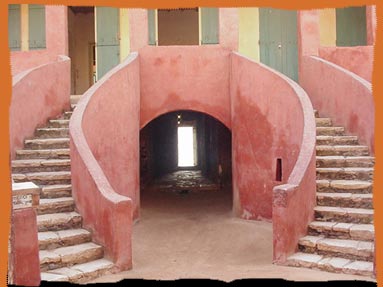 |
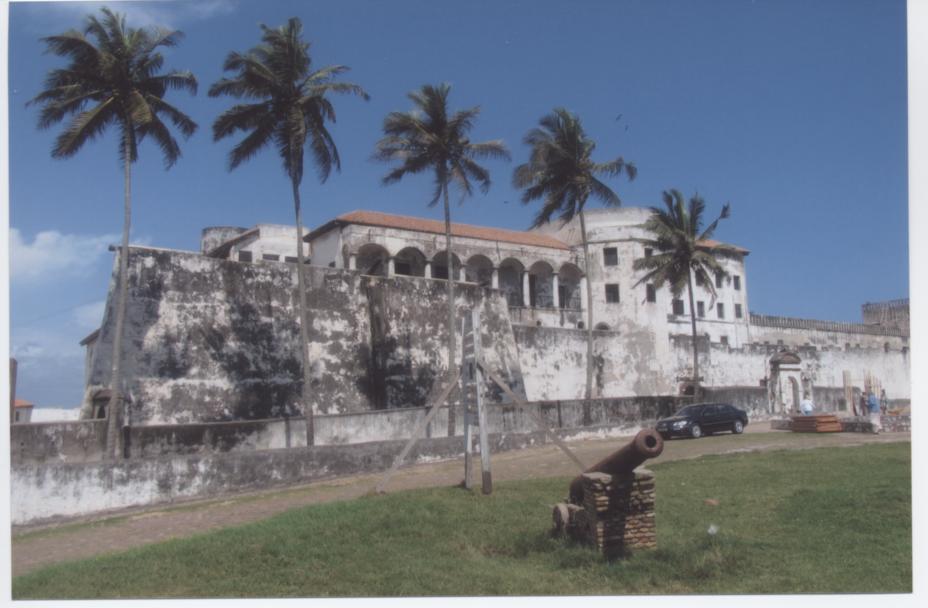 |
Door of No Return, Slave House, Ile de Goree, Senegal Elmina Slave Castle, Ghana
In its day the Cape Coast castle was the center of British colonial rule on the Gold Coast (the colonial name for Ghana) and, more significantly, one of the biggest trading posts of the slave trade. Much larger than the slave homes at Goree, the Cape Coast castle has slave dungeons which held as many as 1,000 male slaves and 500 female slaves at one time. Today they are empty, echoing chambers that barely hint at what they must have been like at the peak of the slave trade in 1700 when more than 650,000 slaves were exported in that year alone.
The numbers are staggering and the tales are overwhelming, almost too great to comprehend. What did hit home, though, was a faded poster on the wall in a little room that announced a sale of slaves. It read in part: “ To be sold on Monday, May 18, 1829, under the trees, three slaves . . . and some books, needles, pins and ribbons.” It was a sad reminder that, back then, it was quite normal to think of slaves, not as human beings, but as objects to be sold along with other household items.
Togo. (Lome). Waking up to the sounds of Africa outside our cabin, we looked out our porthole to see a colorful assembly of drummers and costumed voodoo dancers welcoming the Prinsendam to Lome. Since Togo and neighboring Benin are the center of the voodoo religion in Africa, we chose to spend the afternoon visiting a nearby village to witness a voodoo ceremony.
Unlike the more extreme voodoo practices in Haiti and the Caribbean with their witch doctors, zombies and pin-cushion effigies, African voodoo is a simpler form of the native animistic religion which centers on a pantheon of spirits who are found in nature (i.e. rocks, trees, mountains) and in statues, to whom the natives pray. It is one of the world’s oldest known religions and has been present in Africa since the beginning of human civilization.
After being formally presented to the village chief, we were guests at a series of events which included wild dancing, incessant drumming, trance-like seizures and even a little ‘black magic’. One might tend to be a bit skeptical when sand is turned into rice and a chicken is returned from the dead before your eyes but, if there was a chance that these people really had a solution for both world hunger and eternal life, it seemed prudent to keep an open mind. Besides, you never know when a little juju might come in handy.
Benin. (Cotonou). Neighboring Benin has struggled to establish a stable democracy since its independence from France in 1960. In its first decade as a nation, it had five coups, nine governments and five constitutions. This was followed by a twenty five year experiment with communism. Fortunately, it has been relatively stable since free elections were held there a little over a decade ago.
We bussed to the nearby city of Ouidah, another major slave trading port and home of the notorious Viceroy of Ouidah, a Portuguese adventurer who was granted slaving rights by the King of the Dahomey, became the richest man in all of Africa, fathered 63 sons and an unknown number of daughters, and then just as quickly, fell from power into poverty and madness. The story of the Viceroy of Ouidah is the basis for a fascinating book and a movie (Cobra Verde). All that remains today is a large memorial “Gate of No Return” to mark the place where the slaves were loaded onto ships for transfer across the ocean.
In the afternoon, we visited another voodoo village and paid our respects to the chief. (You can never have too many friends in high places.) Our final adventure was a canoe trip out to Ganvie, a fishing village built two hundred years ago on stilts in the middle of a large coastal lake to protect the people from a warring tribe, which had a taboo against entering the waters. It has remained the home to 30,000 people and boasts a school, hotel and hospital.
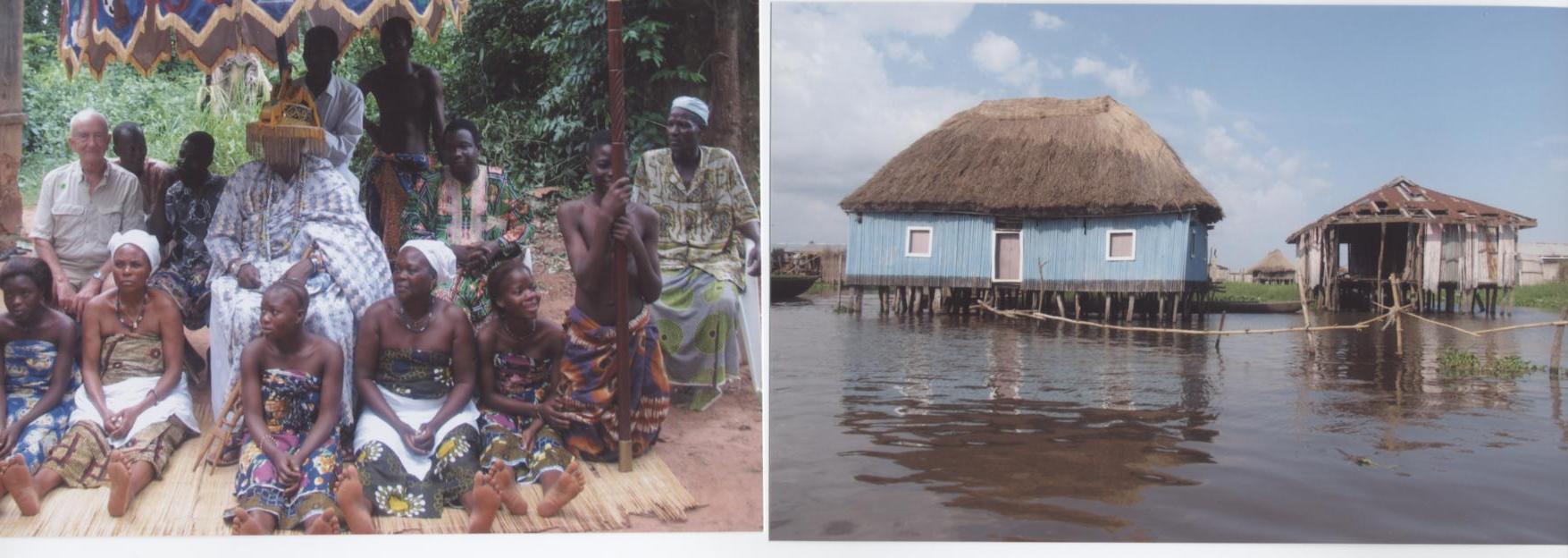 |
Chief of the Voodoo Village, His Retinue and his Advisor - Benin Ganvie Stilt Village - Benin
As we sailed out the Cotonou River (which we learned later means “river of death”) from Benin that evening, the ship made a very noticeable lurch and the Captain announced that we had run aground on an uncharted sandbar at the mouth of the river. After a tense hour, with torrential rains and lightning flashes crashing around us, we were able to clear the sand bar with the help of two tugs, although I like to think that it was my connections with the voodoo chiefs that saved the day.
Cameroon. (Douala) . Originally a German colony, Cameroon was divided between England and France as war reparations following World War One but was eventually reunited into a single country at the time of independence. Since the port city of Douala, like many of the port cities of West Africa that we visited, was dirty, crowded and of little touristic interest, we again chose to leave the city behind and drive out into the countryside. Cameroon’s economy is heavily based on its cocoa, palm seed oil, banana and rubber exports and we visited several plantations and watched the rubber trees being tapped.
Gabon. (Libreville) . Once part of French Equatorial Africa, Gabon has the smallest population (1.2 million people) of the all of the West African countries but its capital city of Libreville reflected a pleasant blend of French and African culture. The city had wide boulevards, modern buildings and ocean front parks, an indication of the benefits that it derives from its oil and uranium resources.
Two of Gabon’s most famous residents were Dr. Albert Schweitzer, medical missionary, organist and winner of the Nobel Peace Prize in 1952 and the so-called pigmy people, who were the original residents of the area but who have long since been driven into the forests where they still live a primitive and isolated life. Since our time was limited we were only able to tour the city and visit a museum.
Namibia and South Africa. Leaving Gabon, our ship resumed a southerly course, crossed the equator and left West Africa behind. We gave several of the less stable countries of the region (Congo and Angola) a wide berth as we passed through their waters and even mounted an anti-piracy watch on the ship during the night hours. (I was sorry that I hadn’t brought my old Navy sword along with me to fight off the pirates just in case!).
Our two final ports of call were Walvis Bay in Namibia and Cape Town in South Africa. Ironically, we had visited both countries just last year but it was great to have a chance to come back if only for a short visit. We took the cable car from Cape Town to the top of Table Mountain which overlooks the city and the Cape of Good Hope at the southernmost tip of Africa. We had reached the end of the African continent and the end of our 7,000 mile journey.
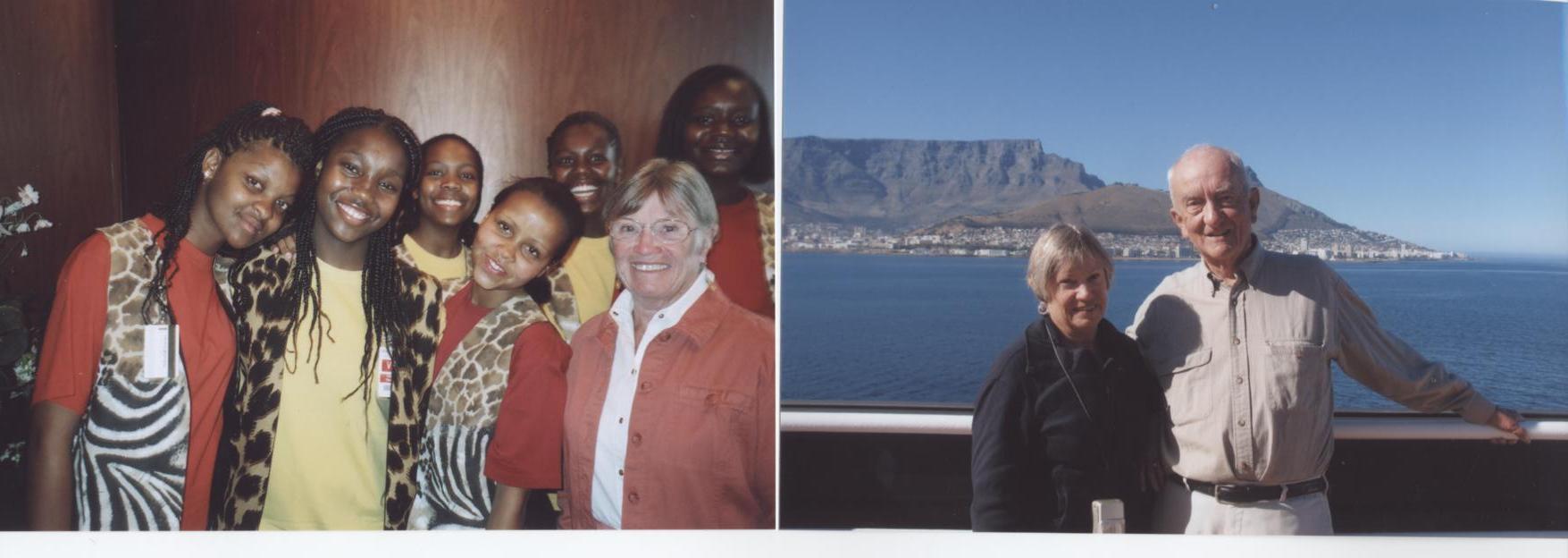 High School Choir - Walvis Bay, Namibia
Table Mountain, Cape Town, South Africa
High School Choir - Walvis Bay, Namibia
Table Mountain, Cape Town, South Africa
We disembarked in Cape Town for our return flight home. After twenty-two days on board, it was hard to leave our ship. The good ship Prinsendam was a five-star, floating hotel with wonderful food, accommodations and service and best of all a comfortable bed to return to each night after our days of exciting adventures on shore.
Most of all, thought, allowed us to visit a fascinating part of the world, to meet new people and to learn about their countries, their history and their lives. And that, for us, is what travel is all about!